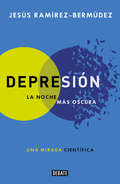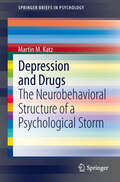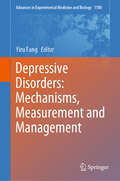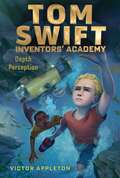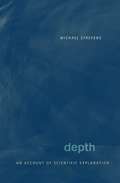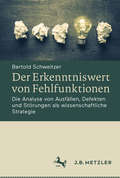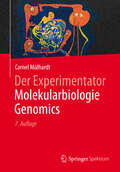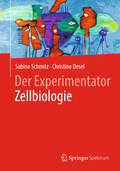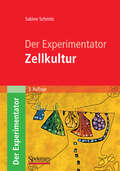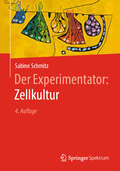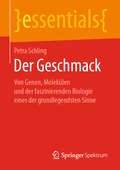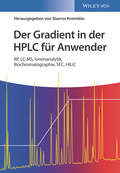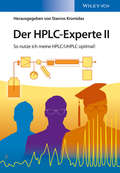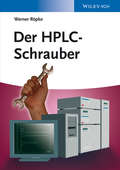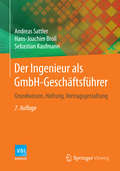- Table View
- List View
Depresión: La noche más oscura
by Jesús Ramírez-BermúdezEs una profunda tristeza, mezclada con miedo y dolor emocional, que roba la energía, el sueño y la concentración; parece que la felicidad está prohibida y que no hay rutas para seguir... Se llama «depresión mayor», y es la noche más oscura. La ciencia conoce muchísimo sobre la depresión. Sabe, por ejemplo, que la genética y las enfermedades pueden desencadenarla, pero también la violencia y la desprotección social. El estrés, las pérdidas, las separaciones familiares, la pobreza, el abuso sexual y el maltrato infantil pueden afectar la salud mental y la armonía de nuestro cuerpo. Pero la ciencia sabe también que hay vías para salir adelante. Desde la psicoterapia y el deporte hasta los medicamentos, hay opciones cuya efectividad es analizada con rigor en esta obra. La psiquiatría clínica, las neurociencias, la psicología y la investigación social tienen mucho que decir. Esta obra relata la larga historiade la depresión, desmonta los mitos que la rodean, presenta datos verificados a partir de los estudios más recientes y explora, ante todo, los caminos para atravesar la noche más oscura.
Depression Conceptualization and Treatment: Dialogues from Psychodynamic and Cognitive Behavioral Perspectives
by Christos Charis Georgia PanayiotouDepression, a highly common clinical disorder, is an important and clinically relevant topic for both clinical researchers and practitioners to address, because of its prevalence, impact on the individual and society, association with other mental and physical health problems and the social contexts in which it develops. Depression ranks in Germany and central Europe as the third among the leading mental disorders and world-wide is a leading cause of disability. It is estimated that 8.3 % of the German population is depressed within a year (11.2 % women, 5.5 % men). These statistics mean that 4 million people per year are depressed in Germany alone (one year prevalence). According to the WHO, over 300 million people world-wide experience depression and in the USA the financial burden of this disorder, due to disability and work absenteeism, reaches Depression is also becoming more frequent over time and has a high risk of recidivism –particularly since its most common form, Major Depressive Disorder (DSM-5; ICD10) tends to occur in episodes. For example, 20% to 40% of people become depressed again within two years after their first depressive episode, meaning that a major aim of any therapeutic intervention should be to prevent future relapses. Depression also shows very high comorbidities with other mental and physical health conditions. Its overlap with anxiety pathology is so high that clinicians are concerned with whether the two disorder categories are indeed distinct or if they show substantial etiological overlap. Depression is also associated with heart disease and even cancer, making it a risk factor for mortality and morbidity that needs to be identified early and addressed effectively. In addition to Major Depressive Disorder, the often severe Bipolar Disorder, and the chronic form of Depression referred to as dysthymia are additional mood disorders that among them require careful differential diagnosis. They also lead to questions regarding their common or distinct etiological mechanisms. In order to gain a better understanding of Depression as a clinical disorder, one needs to look at it as a multifaceted phenomenon. Depression is a neurobehavioral condition, and one has to be up to date and have solid understanding of its biological substrate, at a genetic, neuronal, hormonal and pharmacological level. Depression is also a socio-demographic phenomenon, and one needs to examine its epidemiology, that might contain significant cues towards its clearer understanding. It is more prevalent, for example, in certain regions, climates, age groups and genders (much more prevalent in women, with age of appearance in young adulthood but also presents as a significant problem for youth and the elderly), is associated with stereotypes and stigma and can be the aftermath of crises, trauma and loss. The etiology of Depression remains under scrutiny, though recently much more knowledge is emerging from contemporary neuroimaging, genotyping and data science methods. Different neural and behavioral systems may be involved contributing to the significant heterogeneity within the disorder. Social roles, stressors, attachment patterns, family support and social networks, and individual (e.g. gender linked) vulnerabilities may contribute significantly towards increasing risk for developing depression. Different therapeutic approaches, like those stemming from the psychoanalytic/psychodynamic perspectives and those stemming from the cognitive/behavioral (2nd and 3rd wave) tradition focus on the components of etiology considered most dominant. As science progresses with clearer evidence regarding the important etiological factors and their interactions, these different perspectives, each with its own contribution, may need to take new developments into consideration, adapt and even begin to converge. These different aspects of the topic of Depression, which are central to the scientific aims of clinical scientists, but also permeate the way cl
Depression and Drugs: The Neurobehavioral Structure of a Psychological Storm
by Martin M. KatzThis book integrates the current state of knowledge on the association of neurochemical and psychological factors underlying the concept of depression or on the process and nature of the drug-induced changes that lead to recovery. Highlighting the results of two major multisite collaborative studies of the psychobiology of depression, the author demonstrates how more refined clinical methods uncover the initial behavioral actions of the drugs and chart the time course of their actions. The results disconfirm earlier textbook reported findings that these actions are delayed for several weeks beyond the almost immediate neurochemical effects. The "multivantaged" method makes possible distinguishing the clinical actions of different classes of antidepressant drugs.
Depressive Disorders: Mechanisms, Measurement and Management (Advances in Experimental Medicine and Biology #1180)
by Yiru FangThis book offers a state-of-the-art report on recent discoveries concerning the basic and clinical, neuroscientific and psychiatric findings in depression research. Depressive disorder is a severe and recurrent brain disorder that can manifest in depressive mood, somatic symptoms and cognitive impairment. The underlying mechanisms of depressive disorder and its clinical practice are subjects of long-standing interests. This book is a biologically plausible and multilevel theory which describes neural, physiological, molecular and genomic mechanisms that drive depression pathogenesis, as well as navigates the clinical practice and management for depressive disorder. It mainly describes advances made over the past 20 years on the neural, molecular, neuroimaging, physiology, pathophysiology, pharmacology and internet-based measurement and management of depressive disorder. It will help postgraduate students and academic researchers to get either basic or clinical picture of depressive disorder. Also, it may benefit pharmaceutical companies for developing novel drugs to treat this disease.
Depth Perception (Tom Swift Inventors' Academy #8)
by Victor AppletonTom and his friends&’ service project cleaning up a local lake becomes a deep dive into suspicious behavior in in the eighth novel in Tom Swift Inventors&’ Academy—perfect for fans of The Hardy Boys or Alex Rider.Tom and his friends are excited to be spending their spring break out at Lake Carlopa, where they&’ll be camping and testing inventions to clean up the shores as part of a service project sponsored by Swift Enterprises. Rock star of the engineering world Jonathan J. Jefferson is even set to make an appearance as part of the event. Tom&’s also really looking forward to using the trip as an opportunity to test out his most ambitious creation yet—a two-man submarine! Lake Carlopa is a haven for scuba divers because of its clear waters, and it will be the perfect place for the sub&’s maiden voyage. But when a scuba diving team shows up at the campsite and seems to be there for more than just pleasure diving, Tom and his friends wonder what they&’re really up to. Are the divers using the exhibition as cover for something more sinister?
Depth: An Account of Scientific Explanation
by Michael StrevensWhat does it mean for scientists to truly understand, rather than to merely describe, how the world works? Michael Strevens proposes a novel theory of scientific explanation and understanding that overhauls and augments the familiar causal approach to explanation. What is replaced is the test for explanatorily relevant causal information: Strevens discards the usual criterion of counterfactual dependence in favor of a criterion that turns on a process of progressive abstraction away from a fully detailed, physical causal story. The augmentations include the introduction of a new, non-causal explanatory relevance relationâe"entanglementâe"and an independent theory of the role of black-boxing and functional specification in explanation. The abstraction-centered notion of difference-making leads to a rich causal treatment of many aspects of explanation that have been either ignored or handled inadequately by earlier causal approaches, including the explanation of laws and other regularities, with particular attention to the explanation of physically contingent high-level laws, idealization in explanation, and probabilistic explanation in deterministic systems, as in statistical physics, evolutionary biology, and medicine. The result is an account of explanation that has especially significant consequences for the higher-level sciences: biology, psychology, economics, and other social sciences.
Der Bewerbungs-Coach: Von der Uni in den Job: Infos und Tipps für die perfekte Bewerbung und das erfolgreiche Vorstellungsgespräch
by Martin SutorisVor allem für Uni-/FH-Absolventen ist der Bewerbungsprozess eine gänzlich neue Erfahrung. Es gibt viele Do’s und Dont’s zu beachten, die Informationen in Ratgebern sowie im Internet sind teilweise widersprüchlich, die eigene Vita hat noch nicht allzu viel vorzuweisen - und dann ist da noch das Vorstellungsgespräch… die Erfahrung, mit „wichtigen“ Vorgesetzten und Entscheidern überzeugend zu kommunizieren, fehlt größtenteils. Allein schon bei dem Gedanken sich schriftlich oder persönlich „verkaufen“ zu müssen dreht sich vielen jungen Jobsuchern der Magen um. Der Bewerbungscoach bietet daher auf Grundlage der hoch spezialisierten Erfahrung eines Coaches praxiserprobte Insidertipps an. Drei thematische Blöcke bilden die Substanz des Buches: Die schriftliche Bewerbung: Hier werden Themen wie Design, Rhetorik, Lebenslauf, Struktur angesprochen und mit erfolgreichen Beispielen veranschaulicht. Der rote Faden ist ein Vergleich der typischen Elemente zu der Arbeit eines Bestsellerautors.Das Vorstellungsgespräch: In diesem Teil geht es darum, wie das Gespräch erfolgreich gemeistert werden kann. Hierbei kommen speziell praxiserprobte Methoden des Mentaltriainings und der Kommunikationspsychologie zum Einsatz. So ist es zum Beispiel gut möglich, Lampenfieber in den Griff zu bekommen oder auf die Frage nach den eigenen Schwächen rhetorisch versiert zu kontern sowie die eigene Wirkungskraft deutlich zu erhöhen. Allgemeine Bewerbungsthemen: Nun geht es noch darum, wie und wo man nach passenden Stellen recherchieren kann; wie man der zentralen Frage „Wo will ich eigentlich hin?“ nachspüren kann; wie man während der (ggf. länger andauernden) Erwerbslosigkeit motiviert bleibt. Zudem verraten 6 Karriereexperten ihre besten Tipps.
Der Einfluss von ESG auf das Kreditrisiko: Eine Analyse europäischer Unternehmensanleihen
by Anna GappmaierDie zunehmende Relevanz von ESG (Environmental, Social, and Governance) in der finanzwirtschaftlichen Forschung und Praxis wird angetrieben durch Wesentlichkeit, Investorennachfrage und Regulatorik. Weil Initiativen im Bereich ESG für Unternehmen mit (hohen) Kosten verbunden sind, stellt sich die Frage, ob sich die Investitionen in Bezug auf eine höhere Performance bzw. ein geringeres Risiko „lohnen“. Die bisherige Forschung konzentriert sich v. a. auf die Shareholder-Value-Perspektive. Jüngere Studien untersuchen ESG aus einer Risikoperspektive, vorwiegend eigenkapitalbasiert. Untersuchungen zum Wirkungszusammenhang zwischen ESG und dem Kreditrisiko sind noch spärlich gesät, insbesondere für den europäischen Raum. Aus einer Prinzipal-Agent-theoretischen Sichtweise kann angenommen werden, dass Gläubiger ESG-Investitionen anders bewerten als Eigentümer. Für Gläubiger steht die Bedienung ihrer Zahlungsansprüche aus dem Cash Flow im Vordergrund, sie befürworten grundsätzlich weniger risikoreiche Investitionen. Ziel dieser Untersuchung ist es, einen umfassenden Überblick über die bisherige empirische Literatur zu geben und diese mittels einer eigenen empirischen Untersuchung zu erweitern.
Der Erkenntniswert von Fehlfunktionen: Die Analyse von Ausfällen, Defekten und Störungen als wissenschaftliche Strategie
by Bertold SchweitzerDiese philosophische, interdisziplinäre Studie untersucht, auf welche Weise Fehlfunktionen einen einzigartigen Zugang zu Daten für Entdeckung und Prüfung von Theorien in vielen Wissenschaften bieten. Anhand von Beispielen aus Biologie, Evolution, Linguistik, Kognitionswissenschaft und anderen arbeitet sie die Funktionsweise wissenschaftlicher Methoden heraus, die versuchen, aus der Analyse von Fehlfunktionen Erkenntnisse über normale Struktur und Funktion zu gewinnen. Sie identifiziert die allgemeinen Merkmale, Ziele und Ergebnisse der Methoden (zum Beispiel Zerlegung, Sequenzierung und Lokalisierung von Subsystemen) und untersucht ihre Beziehungen zu konventionellen Strategien der Entdeckung und des Testens, etwa kausale und mechanistische Analyseverfahren.
Der Europäische Emissionshandel: Ein Klimainstrument schreibt Industriegeschichte – Überblick, Zusammenhänge & Ausblick
by Marcel Linnemann Constanze AdolfDas Buch richtet sich an ein breites Publikum, darunter Politiker, Entscheidungsträger, Wissenschaftler und Interessierte, die ein Verständnis für die Funktionsweise des Emissionshandelssystems sowie seine Auswirkungen auf die Energiewende und die Industrie in Europa erlangen möchten. Es bietet eine sachliche Analyse und einen schnellen aber fundierten Einblick in die komplexe Thematik, um einen fundierten Diskurs über die Effektivität und die Herausforderungen des Emissionshandels zu ermöglichen.
Der Experimentator Molekularbiologie / Genomics
by Cornel MülhardtDieses Buch enthält das Grundlagenwissen sowie Tipps und Tricks für den Umgang mit Nucleinsäuren. Der Autor kennt Lust und Frust der täglichen Laborroutine ganz genau. Präparieren, Fällen, Konzentrieren und Reinigen von NucleinsäurenRestriktionsenzyme, Gele, BlottenPolymerase-KettenreaktionRNA-Isolierung, -TranskriptionKlonierung von DNA-FragmentenMarkierung von Sonden, Hybridisierung, Screening, SequenzierungMutagenese, In-vitro-Translation, transgene Mäuse, Transgenexpression, Gentherapie, GenomikDieses Buch richtet sich an alle Experimentatoren, die molekularbiologische Versuche durchführen wollen und gern nachvollziehen möchten, was sich in ihrem Reaktionsgefäß abspielt. Das ganze Spektrum der üblichen molekularbiologischen Methoden wird vorgestellt, kommentiert und Alternativen aufgezeigt. Der lockere Ton wendet sich gleichermaßen an Studenten wie an BTAs und Laboranten, aber auch der alte Hase wird hier und dort noch etwas Neues entdecken. Die 7. Auflage wurde überarbeitet und aktualisiert.
Der Experimentator Zellbiologie (Experimentator)
by Sabine Schmitz Christine DeselLieber EXPERIMENTATOR,dieser neue Zellbio-EXPERIMENTATOR stellt die wichtigsten Grundlagen im Bereich Zellbiologie vor und erklärt moderne Techniken, die in diesem Forschungsfeld ihre Anwendung finden. Die breite Themenauswahl - von Routineverfahren bis hin zu neuen anspruchsvollen Methoden – hilft Neulingen beim Einstieg in die Praxis und bereichert die Arbeit von erfahrenen Experimentatoren. Anhand von leicht nachvollziehbaren Protokollen, vielen wegweisenden Tipps, Tricks und Literaturempfehlungen erhält der Leser das Rüstzeug für die Bearbeitung und Beantwortung von zellbiologischen Fragestellungen. Durch die Erörterung von Besonderheiten, von Vor- und Nachteilen einer Methode, wird ein Gespür für sinnvolle Analysestrategien geweckt und ein Fundament für erfolgreiches Forschen geschaffen. Praktikanten, technische Assistenten, Studierende, Doktoranden und Forschende in den Naturwissenschaften, der Pharmazie oder der Biotechnologie profitieren von diesem Werk.
Der Experimentator: Zellkultur
by Sabine SchmitzDieses Buch ist eine Orientierungshilfe im verwirrenden Dschungel von Zellen, Medien, Seren, Supplementen und Vorschriften. Die 3. Auflage wurde um Trendthemen wie Laborautomation und tissue engineering erweitert. Steriltechnik, Subkultur, Adhäsion und Detachment werden verständlich dargestellt. Ein Überblick über den aktuellen Stand von Verordnungen und Regelwerken ist enthalten. Das Buch richtet sich an Studierende, Praktikanten, technische Assistenten, Doktoranden und an alle, die sich Begleiter im Laboralltag wünschen, der Hilfestellung bei Problemen anbietet.
Der Experimentator: Zellkultur (Experimentator)
by Sabine SchmitzDieses Buch ist eine Orientierungshilfe im verwirrenden Dschungel von Zellen, Medien, Seren, Supplementen und Vorschriften. Die 3. Auflage wurde um Trendthemen wie Laborautomation und tissue engineering erweitert. Steriltechnik, Subkultur, Adhäsion und Detachment werden verständlich dargestellt. Ein Überblick über den aktuellen Stand von Verordnungen und Regelwerken ist enthalten.Das Buch richtet sich an Studierende, Praktikanten, technische Assistenten, Doktoranden und an alle, die sich Begleiter im Laboralltag wünschen, der Hilfestellung bei Problemen anbietet.
Der Geist der kritischen Schule: Kantisches Denken in der Tradition von Jakob Friedrich Fries und Leonard Nelson im 20. Jahrhundert: Wirkungen und Aktualität
by Kay Herrmann Boris SchwitzerPhilosophie als Wissenschaft, als Grundlagendisziplin und als interdisziplinäre Forschung: Ansätze, die sich eine zu Unrecht fast vergessene philosophische Schule zu eigen gemacht hat, nämlich die 1903 neu gegründete Fries’sche Schule um den Göttinger Philosophen Leonard Nelson (1882-1927). Sie steht in der Tradition der Philosophie Immanuel Kants (1724-1804) und Jakob Friedrich Fries' (1773-1843). Der Nelsonkreis hält dem Vergleich mit dem Wiener Kreis stand. Die Anhänger des Nelsonkreises kamen u.a. aus der Mathematik, Physik, Philosophie, Psychologie, Theologie und den Sozial- und Wirtschaftswissenschaften. Über sie wirkte die kantisch-friessche Philosophie teilweise in andere Disziplinen hinein. Zu nennen sind beispielsweise der Psychiater und Psychologe Arthur Kronfeld (1846-1941), der Biochemiker und Nobelpreisträger Otto Meyerhof (1884-1951), der Mathematiker Gerhard Hessenberg (1874-1925), die Philosophin und Physikerin Grete Henry-Hermann (1901-1984), die Pädagogin MinnaSpecht (1879-1961), der Wirtschaftswissenschaftler Alexander Rüstow (1885-1963), der Theologe Rudolf Otto (1869-1937), der Soziologe Franz Oppenheimer (1864-1943) und der Sozialwissenschaftler Gerhard Weisser (1898-1989).Die Ausstrahlung des Nelsonkreises auf verschiedene Disziplinen sowie dessen Geschichte sind bislang noch nicht umfassend untersucht worden. Diese Forschungslücke soll mit dem vorliegenden Band geschlossen werden. Der systematische Forschungsband bietet zudem eine Einführung und einen Überblick zur Philosophie Leonard Nelsons.
Der Geschmack: Von Genen, Molekülen und der faszinierenden Biologie eines der grundlegendsten Sinne (essentials)
by Petra SchlingPetra Schling gibt in diesem essential einen Überblick über den aktuellen Stand der Forschung zum Thema Geschmack. Dabei betrachtet sie Geschmack als Sinneswahrnehmung, die uns erlaubt, essenzielle Nahrungsbestandteile von Giften zu unterscheiden. Was wir essen hängt nicht unwesentlich davon ab, wie es uns schmeckt. Aber wie schmecken wir eigentlich – und was überhaupt? Als Omnivoren (Allesfresser) besitzen wir Menschen eine relativ breite Palette an Geschmacks-Rezeptoren nicht nur im Mund, die uns wichtige Informationen über unsere Nahrung vermitteln. Außerhalb des Mundes dienen Geschmackssinneszellen unserer angeborenen Immunabwehr dazu, Bakterien, Würmer und andere Eindringlinge zu „schmecken“. Darauf können und sollten wir uns verlassen. Unser Geschmackssinn warnt uns vor Giften und unerwünschten Mitbewohnern und lässt sich nur sehr bedingt durch Süßstoffe, Bitterblocker oder ähnliche Tricks täuschen.
Der Gradient in der HPLC für Anwender: RP, LC-MS, Ionenanalytik, Biochromatographie, SFC, HILIC
by Stavros KromidasDer HPLC-Experte
by Stavros KromidasDer rasanten Entwicklung auf dem Gebiet der HPLC wird mit diesem Buch Rechnung getragen: Von Gradientenoptimierung über Kopplungs- und 2D-Techniken bis zu Dokumentation und Informationsbeschaffung - aktuell und kompakt geschrieben von Praktikern für Praktiker.Inhalt:1 LC/MS-Kopplung 1.1 Stand der Technik in der LC/MS-Kopplung 1.2 Technische Aspekte und Fallstricke der LC/MS-Kopplung 1.3 LC/MS-Kopplung - ein praktisches Beispiel aus der Ionenchromatographie2 HPLC-GC-Kopplung in der Praxis; Theorie, Applikationsbeispiele und Ausblick3 Optimisierungsstrategien in der RP-HPLC4 Der Gradient in der RP-Chromatographie4.1 Aspekte der Gradienten-Optimierung4.2 Vorhersagen von Gradienten5 Vergleich und Auswahl von modernen HPLC-Säulen6 Trenntechniken in der Biochromatographie7 Moderne HPLC-Softwareprogramme - Eigenschaften, Vergleich, Ausblick8 Möglichkeiten der "richtigen" Integration heute9 HPLC im reglementierten Bereich9.1 Intelligente Dokumentationen9.2 Tipps für eine gelungene FDA-Inspektion10 Effiziente Informationsbeschaffung im Zeitalter von Web 2.0 am Beispiel der HPLC11 Trends in der Detektionstechnik
Der HPLC-Experte II
by Stavros KromidasErstmalig in einem Buch liegt die moderne HPLC/UHPLC-Anlage im Fokus. In kompakter Form wird gezeigt, wie die verschiedenen Geräte für eine maximale Auflösung optimal genutzt werden können. Aber auch wie vorzugehen ist, wenn eher die Robustheit im Vordergrund steht. Praxisnah erfährt der erfahrene Leser welche Möglichkeiten ihm heute zur Verfügung stehen aber auch wo die Grenzen einer modernen HPLC/UHPLC-Anlage liegen. Ein Handbuch von Praktikern für Praktiker. Teil 1* Wann sollte ich meine UHPLC als UHPLC betreiben?* Die moderne HPLC/UHPLC-Anlage* Die Anforderungen heute an die einzelne Module* Der Säulenthermostat - eine einfache Angelegenheit?* Das Problem der Bandenverbreiterung in einer HPLC/UHPLC-Anlage* Der Gradient; Anforderungen, optimaler Einsatz, Tricks und Fallstricke* Anforderungen an LC-Hardware bei der Kopplung mit unterschiedlichen Massenspektrometern* 2D-Chromatographie - Möglichkeiten und Grenzen* Materialien in HPLC/UHPLC - was, für welchen Zweck? Teil 2* Was muss die Software können, damit die Hardware optimal genutzt werden kann?* Aspekte der modernen HPLC - Erfahrungsbericht eines Anwenders* Erfahrungsbericht eines unabhängiges Serviceingenieurs - Tipps und* Empfehlungen für einen optimalen Betrieb von Agilent- und Waters-Anlagen Der Analyt, die* Fragenstellung und die UHPLC - der Einsatz von UHPLC in der Praxis* Geräte-Hersteller berichten - Beiträge von Agilent, Shimadzu und Thermo Scientific
Der HPLC-Schrauber
by Werner R¿pkeProbe ins Gerät stellen, Knopf drücken, Ergebnis erhalten – so reibungslos verläuft der Laboralltag mit HPLC-Geräten selten. Oft sind es Kleinigkeiten, die zu Störungen führen, und nicht immer muss der Kundendienst sofort bestellt werden. Wer weiß, an welchen Teilen geschraubt werden darf und an welchen nicht, kann kleine Probleme selbst beheben – leicht, schnell, ohne großen Kostenaufwand. Mit dem gesammelten Wissen aus dreißig Jahren Serviceerfahrung führt der HPLCSchrauber den Anwender an Aufbau und Funktionsweise seines Gerätes heran und verzichtet dabei bewusst auf theoretischen Ballast. Stattdessen zeigen wertvolle Hinweise, die so nicht in den Handbüchern der Hersteller zu fi nden sind, wie man Fehlerquellen aufdeckt und beseitigt. Aus der Praxis für die Praxis – für alle Schrauberinnen und Schrauber, die gern selbst zum Werkzeug greifen, wenn das HPLC-Gerät mal wieder nicht so funktioniert, wie es soll
Der Higgs-Mechanismus: Entwicklung einer Fortbildung für Lehrkräfte inklusive Handreichung (BestMasters)
by Eric WeißIm Juli 2012 prägte ein besonderes Thema aus der Physik die Medienlandschaft. Das letzte unbekannte Elementarteilchen des sogenannten Standardmodells der Teilchenphysik, das Higgs-Boson, konnte am Large Hadron Collider (LHC) am CERN in der Schweiz erstmals nachgewiesen werden. Es bleibt jedoch die Frage offen, um was es sich beim zugrunde liegenden Higgs-Mechanismus und beim Higgs-Teilchen an sich eigentlich handelt. Selbst Lehrkräfte des Faches Physik stoßen bei diesem Thema an ihre Grenzen. Ziel dieses Werks ist die Erarbeitung einer Fortbildung für Lehrkräfte des Faches Physik. Dazu wird der Higgs-Mechanismus in Form einer wissenschaftlichen Aufarbeitung Schritt für Schritt, unterstützt von ausgewählten Werken, aufgearbeitet.
Der Himmel ist nicht genug – Wissenschaft ist die beste Religion
by Hanna HeikenwälderDie Naturwissenschaft beschäftigt sich mit denselben großen Fragen wie Religion und Philosophie. Dabei verlässt sie sich jedoch nicht auf menschliche Vorlieben, Eingebung oder Logik, sondern erforscht unvoreingenommen die Natur. Ihr ewiges Hinterfragen, Testen und Korrigieren ist ehrlicher und demütiger, als veraltete Weltanschauungen und Konzepte kritiklos als „Palliativbehandlung“ gegen Ängste und Sorgen zu akzeptieren. Die Existenz von Atomen und Naturgesetzen ist keineswegs gleichbedeutend mit einer „Entzauberung“ des Lebens oder dem Verlust aller „erhabenen“ Gefühle - nur weil wir nicht mit Unwahrheiten um uns werfen dürfen. Die Natur hält spannendere und faszinierendere Wunder und Rätsel für uns bereit, als alle Formen von zusammenhangslosem Aberglaube, Mystizismus oder Verschwörungstheorien:Was geschah beim Urknall und welche Form hat das Universum? Sind wir allein im Universum?Was hat es mit der geheimnisvollen dunklen Energie auf sich? Warum altern wir in der Nähe Schwarzer Löcher langsamer? Und was ist eigentlich eine Weltformel, nach der alle so verzweifelt suchen?Zweifeln ist keine Schwäche, sondern eine ganz besondere Stärke. Ohne die Fähigkeit Fehler zu erkennen und die Bereitschaft, sich immer wieder selbst zu korrigieren, kämen wir der Wahrheit niemals näher. In ihrer kreativen Unvoreingenommenheit lehnen Naturwissenschaftler überirdische Schöpfer unseres Universums nicht kategorisch ab. Sie wollen einfach nur wissen, was wirklich stimmt.
Der Ingenieur als GmbH-Geschäftsführer
by Sebastian Kaufmann Hans-Joachim Broll Andreas SattlerDie meisten GmbHs werden von Geschäftsführern geleitet, die weder Juristen noch Betriebswirte sind. Für sie bietet der Band wichtige Hinweise zu Haftungsfragen, Strafvorschriften, Sorgfaltspflichtverletzungen und der Verantwortung der GmbH Dritten gegenüber. Die zahlreichen Beispiele und Fälle sind sorgfältig ausgewählt und auf Ingenieure als GmbH-Geschäftsführer zugeschnitten. Für die Neuauflage wurde das neue GmbH-Recht (MoMiG) berücksichtigt, u. a. die Einkommenstabellen aktualisiert sowie ein Kapitel über Steuerfragen einer GmbH ergänzt.
Der Ingenieur als GmbH-Geschäftsführer: Grundwissen, Haftung, Vertragsgestaltung (VDI-Buch)
by Sebastian Kaufmann Hans-Joachim Broll Andreas SattlerIn der nunmehr 7. Auflage des Buches wurden die rechtlichen Ausführungen, das Kapitel über Steuern der GmbH sowie die Jahresbezüge von Geschäftsführern aktualisiert.Die meisten GmbHs werden von Geschäftsführern geleitet, die weder Juristen noch Betriebswirte sind. Deshalb gibt dieses Buch wichtige Hinweise zu Themen wie Haftungsfragen, Strafvorschriften, Sorgfaltspflichtverletzungen und Verantwortung der GmbH Dritten gegenüber. Die zahlreichen Beispiele und Fälle sind sorgfältig ausgewählt und genau auf den Ingenieur als GmbH-Geschäftsführer abgestimmt.
Der Klimaschutz-Kompass: Wie wir gut und klimafreundlich leben können
by Heimo BürbaumerWie können wir klimafreundlich leben? Sind Elektro- oder Hybrid-Autos effektiver? Sollte man regionale Lebensmittel kaufen oder Bio-Produkte? Wie mache ich mein Haus klimafit? Basierend auf dem aktuellen Stand der Energie- und Klimaschutzberatung beschreibt das Buch für alle Lebensbereiche – von der Mobilität über Wohnen bis zu Ernährung und Konsum – Maßnahmen, die je mindestens eine Tonne CO2 einsparen und dabei die Lebensqualität erhöhen. Dabei räumt der Autor mit gängigen Mythen wie der Gleichsetzung von Klimaschutz und Verzicht auf und gibt im Wirrwarr der Medienberichte vom Wasserstoffauto bis zur CO2-Kompensation Orientierung. Denn klimafreundlich leben bedeutet eine bewusste Entscheidung für fossilfreie Technologien und zukunftstaugliche Lebensweisen jetzt und nicht erst in ferner Zukunft. Das Buch richtet sich an alle, die klimafreundlich ihren Alltag meistern wollen, aber nicht wissen, wie dies effektiv und ohne Verzicht umsetzbar ist. Der Klimaschutz-Kompass gibt dazu eine einfach verständliche, wissenschaftlich begründete Anleitung, wie eine klimafreundliche Lebensweise alltagstauglich umsetzbar ist.
